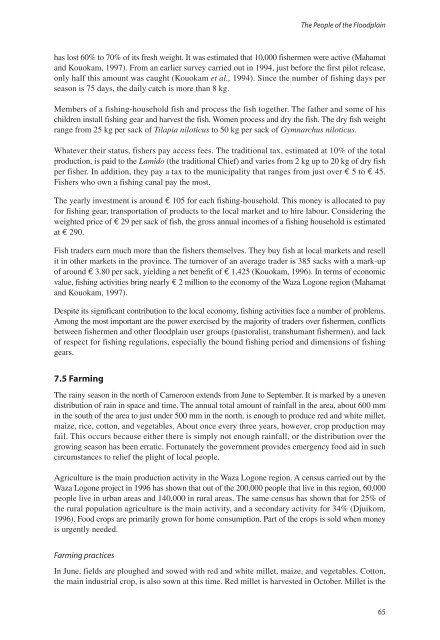The return of the water - IUCN
The return of the water - IUCN
The return of the water - IUCN
Create successful ePaper yourself
Turn your PDF publications into a flip-book with our unique Google optimized e-Paper software.
has lost 60% to 70% <strong>of</strong> its fresh weight. It was estimated that 10,000 fishermen were active (Mahamat<br />
and Kouokam, 1997). From an earlier survey carried out in 1994, just before <strong>the</strong> first pilot release,<br />
only half this amount was caught (Kouokam et al., 1994). Since <strong>the</strong> number <strong>of</strong> fishing days per<br />
season is 75 days, <strong>the</strong> daily catch is more than 8 kg.<br />
Members <strong>of</strong> a fishing-household fish and process <strong>the</strong> fish toge<strong>the</strong>r. <strong>The</strong> fa<strong>the</strong>r and some <strong>of</strong> his<br />
children install fishing gear and harvest <strong>the</strong> fish. Women process and dry <strong>the</strong> fish. <strong>The</strong> dry fish weight<br />
range from 25 kg per sack <strong>of</strong> Tilapia niloticus to 50 kg per sack <strong>of</strong> Gymnarchus niloticus.<br />
Whatever <strong>the</strong>ir status, fishers pay access fees. <strong>The</strong> traditional tax, estimated at 10% <strong>of</strong> <strong>the</strong> total<br />
production, is paid to <strong>the</strong> Lamido (<strong>the</strong> traditional Chief) and varies from 2 kg up to 20 kg <strong>of</strong> dry fish<br />
per fisher. In addition, <strong>the</strong>y pay a tax to <strong>the</strong> municipality that ranges from just over € 5 to € 45.<br />
Fishers who own a fishing canal pay <strong>the</strong> most.<br />
<strong>The</strong> yearly investment is around € 105 for each fishing-household. This money is allocated to pay<br />
for fishing gear, transportation <strong>of</strong> products to <strong>the</strong> local market and to hire labour. Considering <strong>the</strong><br />
weighted price <strong>of</strong> € 29 per sack <strong>of</strong> fish, <strong>the</strong> gross annual incomes <strong>of</strong> a fishing household is estimated<br />
at € 290.<br />
Fish traders earn much more than <strong>the</strong> fishers <strong>the</strong>mselves. <strong>The</strong>y buy fish at local markets and resell<br />
it in o<strong>the</strong>r markets in <strong>the</strong> province. <strong>The</strong> turnover <strong>of</strong> an average trader is 385 sacks with a mark-up<br />
<strong>of</strong> around € 3.80 per sack, yielding a net benefit <strong>of</strong> € 1,425 (Kouokam, 1996). In terms <strong>of</strong> economic<br />
value, fishing activities bring nearly € 2 million to <strong>the</strong> economy <strong>of</strong> <strong>the</strong> Waza Logone region (Mahamat<br />
and Kouokam, 1997).<br />
Despite its significant contribution to <strong>the</strong> local economy, fishing activities face a number <strong>of</strong> problems.<br />
Among <strong>the</strong> most important are <strong>the</strong> power exercised by <strong>the</strong> majority <strong>of</strong> traders over fishermen, conflicts<br />
between fishermen and o<strong>the</strong>r floodplain user groups (pastoralist, transhumant fishermen), and lack<br />
<strong>of</strong> respect for fishing regulations, especially <strong>the</strong> bound fishing period and dimensions <strong>of</strong> fishing<br />
gears.<br />
7.5 Farming<br />
<strong>The</strong> People <strong>of</strong> <strong>the</strong> Floodplain<br />
<strong>The</strong> rainy season in <strong>the</strong> north <strong>of</strong> Cameroon extends from June to September. It is marked by a uneven<br />
distribution <strong>of</strong> rain in space and time. <strong>The</strong> annual total amount <strong>of</strong> rainfall in <strong>the</strong> area, about 600 mm<br />
in <strong>the</strong> south <strong>of</strong> <strong>the</strong> area to just under 500 mm in <strong>the</strong> north, is enough to produce red and white millet,<br />
maize, rice, cotton, and vegetables. About once every three years, however, crop production may<br />
fail. This occurs because ei<strong>the</strong>r <strong>the</strong>re is simply not enough rainfall, or <strong>the</strong> distribution over <strong>the</strong><br />
growing season has been erratic. Fortunately <strong>the</strong> government provides emergency food aid in such<br />
circumstances to relief <strong>the</strong> plight <strong>of</strong> local people.<br />
Agriculture is <strong>the</strong> main production activity in <strong>the</strong> Waza Logone region. A census carried out by <strong>the</strong><br />
Waza Logone project in 1996 has shown that out <strong>of</strong> <strong>the</strong> 200,000 people that live in this region, 60,000<br />
people live in urban areas and 140,000 in rural areas. <strong>The</strong> same census has shown that for 25% <strong>of</strong><br />
<strong>the</strong> rural population agriculture is <strong>the</strong> main activity, and a secondary activity for 34% (Djuikom,<br />
1996). Food crops are primarily grown for home consumption. Part <strong>of</strong> <strong>the</strong> crops is sold when money<br />
is urgently needed.<br />
Farming practices<br />
In June, fields are ploughed and sowed with red and white millet, maize, and vegetables. Cotton,<br />
<strong>the</strong> main industrial crop, is also sown at this time. Red millet is harvested in October. Millet is <strong>the</strong><br />
65












